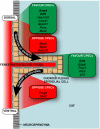Development of the choroid plexus and blood-CSF barrier
- PMID: 25784848
- PMCID: PMC4347429
- DOI: 10.3389/fnins.2015.00032
Development of the choroid plexus and blood-CSF barrier
Abstract
Well-known as one of the main sources of cerebrospinal fluid (CSF), the choroid plexuses have been, and still remain, a relatively understudied tissue in neuroscience. The choroid plexus and CSF (along with the blood-brain barrier proper) are recognized to provide a robust protective effort for the brain: a physical barrier to impede entrance of toxic metabolites to the brain; a "biochemical" barrier that facilitates removal of moieties that circumvent this physical barrier; and buoyant physical protection by CSF itself. In addition, the choroid plexus-CSF system has been shown to be integral for normal brain development, central nervous system (CNS) homeostasis, and repair after disease and trauma. It has been suggested to provide a stem-cell like repository for neuronal and astrocyte glial cell progenitors. By far, the most widely recognized choroid plexus role is as the site of the blood-CSF barrier, controller of the internal CNS microenvironment. Mechanisms involved combine structural diffusion restraint from tight junctions between plexus epithelial cells (physical barrier) and specific exchange mechanisms across the interface (enzymatic barrier). The current hypothesis states that early in development this interface is functional and more specific than in the adult, with differences historically termed as "immaturity" actually correctly reflecting developmental specialization. The advanced knowledge of the choroid plexus-CSF system proves itself imperative to understand a range of neurological diseases, from those caused by plexus or CSF drainage dysfunction (e.g., hydrocephalus) to more complicated late-stage diseases (e.g., Alzheimer's) and failure of CNS regeneration. This review will focus on choroid plexus development, outlining how early specializations may be exploited clinically.
Keywords: blood-CSF barrier; brain patterning; cerebrospinal fluid; choroid plexus; development; epithelia; neuroependyma.
Figures




Similar articles
-
Development of the choroid plexus.Microsc Res Tech. 2001 Jan 1;52(1):5-20. doi: 10.1002/1097-0029(20010101)52:1<5::AID-JEMT3>3.0.CO;2-J. Microsc Res Tech. 2001. PMID: 11135444 Review.
-
Merging Transport Data for Choroid Plexus with Blood-Brain Barrier to Model CNS Homeostasis and Disease More Effectively.CNS Neurol Disord Drug Targets. 2016;15(9):1151-1180. doi: 10.2174/1871527315666160915120758. CNS Neurol Disord Drug Targets. 2016. PMID: 27633784 Review.
-
The choroid plexus-cerebrospinal fluid system: from development to aging.Curr Top Dev Biol. 2005;71:1-52. doi: 10.1016/S0070-2153(05)71001-2. Curr Top Dev Biol. 2005. PMID: 16344101 Review.
-
The choroid plexus-cerebrospinal fluid interface in Alzheimer's disease: more than just a barrier.Neural Regen Res. 2016 Apr;11(4):534-7. doi: 10.4103/1673-5374.180372. Neural Regen Res. 2016. PMID: 27212900 Free PMC article. Review.
-
Demonstration of a coupled metabolism-efflux process at the choroid plexus as a mechanism of brain protection toward xenobiotics.J Neurosci. 1999 Aug 1;19(15):6275-89. doi: 10.1523/JNEUROSCI.19-15-06275.1999. J Neurosci. 1999. PMID: 10414957 Free PMC article.
Cited by
-
Emerging roles for CNS fibroblasts in health, injury and disease.Nat Rev Neurosci. 2022 Jan;23(1):23-34. doi: 10.1038/s41583-021-00525-w. Epub 2021 Oct 20. Nat Rev Neurosci. 2022. PMID: 34671105 Free PMC article. Review.
-
Alix-mediated assembly of the actomyosin-tight junction polarity complex preserves epithelial polarity and epithelial barrier.Nat Commun. 2016 Jun 23;7:11876. doi: 10.1038/ncomms11876. Nat Commun. 2016. PMID: 27336173 Free PMC article.
-
Cerebrospinal fluid proteomics in patients with Alzheimer's disease reveals five molecular subtypes with distinct genetic risk profiles.Nat Aging. 2024 Jan;4(1):33-47. doi: 10.1038/s43587-023-00550-7. Epub 2024 Jan 9. Nat Aging. 2024. PMID: 38195725 Free PMC article.
-
Characterization of choroid plexus in the preterm rabbit pup following subcutaneous administration of recombinant human IGF-1/IGFBP-3.Fluids Barriers CNS. 2023 Aug 15;20(1):59. doi: 10.1186/s12987-023-00460-1. Fluids Barriers CNS. 2023. PMID: 37582792 Free PMC article.
-
Aluminium co-localises with Biondi ring tangles in Parkinson's disease and epilepsy.Sci Rep. 2022 Jan 27;12(1):1465. doi: 10.1038/s41598-022-05627-8. Sci Rep. 2022. PMID: 35087154 Free PMC article.
References
-
- al-Sarraf H., Preston J. E., Segal M. B. (1997b). Changes in the kinetics of the acidic amino acid brain and CSF uptake during development in the rat. Brain Res. Dev. Brain Res. 102, 27–134. - PubMed
Publication types
LinkOut - more resources
Full Text Sources
Other Literature Sources

